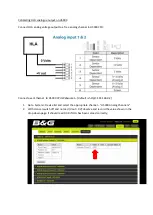
7I47S 9
OPERATION
ANALOG OUT
The 7I47S provides one analog output for spindle control. The analog output is a
isolated potentiometer replacement type device. It functions like a potentiometer with
ANALOG + being one end of the potentiometer, ANALOG OUT being the wiper and
ANALOG- being the other end. The voltage on ANALOG out can be set to any voltage
between ANALOG- and . Polarity and voltage range must always be observed
for proper operation. The voltage supplied between and ANALOG- must be
between 5VDC an 15VDC with always being more positive than ANALOG-.
The analog output voltage is set by PWM from the controller. The optimum PWM
frequency is approximately 5KHz, Higher frequencies will have lower ripple but more non-
linearity, lower frequencies will have better linearity but more ripple.
A 50% duty cycle PWM signal will result in a 50 % voltage output. The voltage
output is gated by the ENABLE interface signal, and forced to = ANALOG- when enable
is not asserted (enable is active low at the FPGA interface level).
Because the analog output is isolated, bipolar output is possible, for example with
connected to 5V and ANALOG- connected to -5V, a +=5V analog output range
is created. In this case the PWM output must be offset so that 50% PWM is generated
when a 0V output is required. Note that id bipolar output is used, the output will be forced
to ANALOG- at startup or when ENABLE is false.
ISOLATED OUTPUTS
The 7I47S provides 3 isolated outputs for use for spindle direction control, spindle
enable or other applications. These outputs are OPTO coupler Darlington transistors. They
are all isolated from one another so can be used for pull up or pull-down individually. They
will switch a maximum of 50 mA at 0 to 100 VDC. The ENABLE output is special as it uses
the same signal that enables the analog output. When the analog output is enabled, the
ENABLE OPTO output is on. The DIR and AUX outputs have no special functions so may
be used for any purpose.































